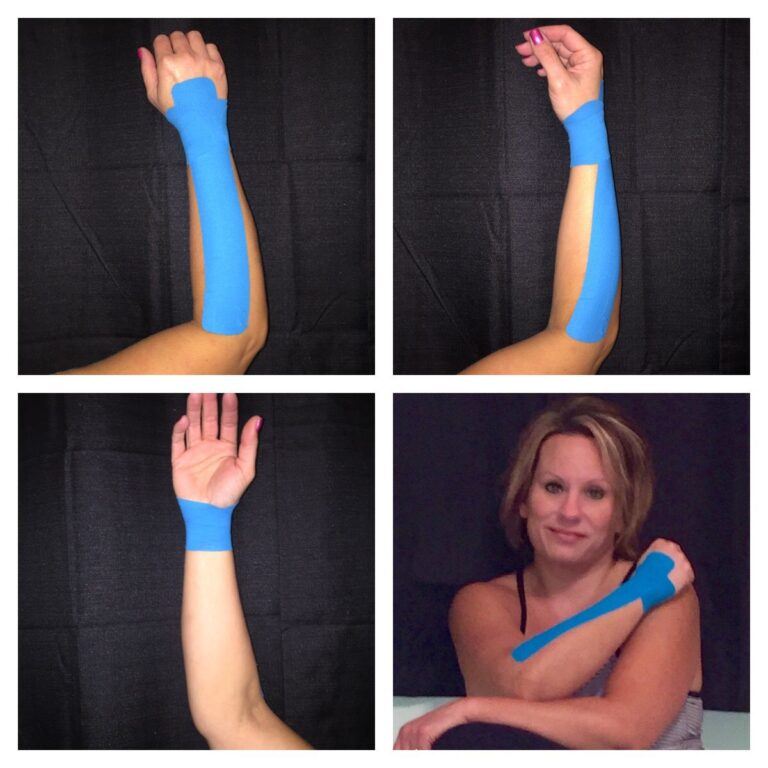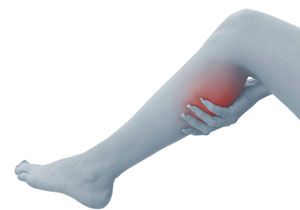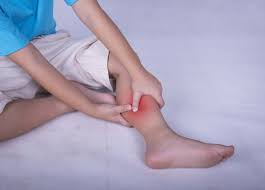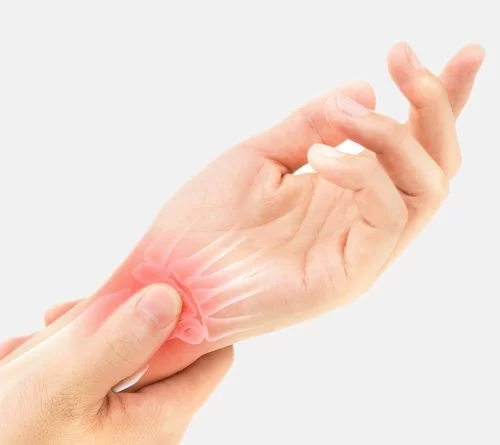Quadriceps muscle strain: Cause, Symptoms, Treatment, Exercise
Table of Contents
What is a quadriceps muscle strain?
- A quadriceps muscle strain is a partial tear of the small fibers of the big group of muscles in the front of the thigh.
- A quadriceps strain is an acute tearing of the quadriceps muscle. This injury is generally due to an acute stretch of the quadriceps muscle, again and again at the same time as a forceful compression or repetitious functional overloading. The quadriceps, which consists of four-zone, can be overloaded by repeated eccentric muscle compression of the knee extensor mechanism.
- Acute strain injuries of the quadriceps generally do in athletic competitions similar to soccer, rugby, and football. Do these sports regularly require unexpected forceful eccentric compression of the quadriceps during regulation of the knee extension and hip extension. high-rise forces over the muscle-tendon units with eccentric contraction can lead to quadriceps strain injury.
- More passive stretching or activation of a maximally stretched muscle can also cause strains. Of the quadriceps muscles, the rectus femoris is most constantly strained. Several factors dispose of this muscle and others to added frequent strain injury. Do these include muscles crossing two joints, those with a high probability of Type II fibers, and muscles with complex musculotendinous architecture.
- Muscle fatigue has also been shown to play a part in acute muscle injury
Where is the quadriceps located?
- It is located in the anterior section of the thigh. They form the main mass of the thigh
- The Quadriceps muscles consists of four individual muscles:
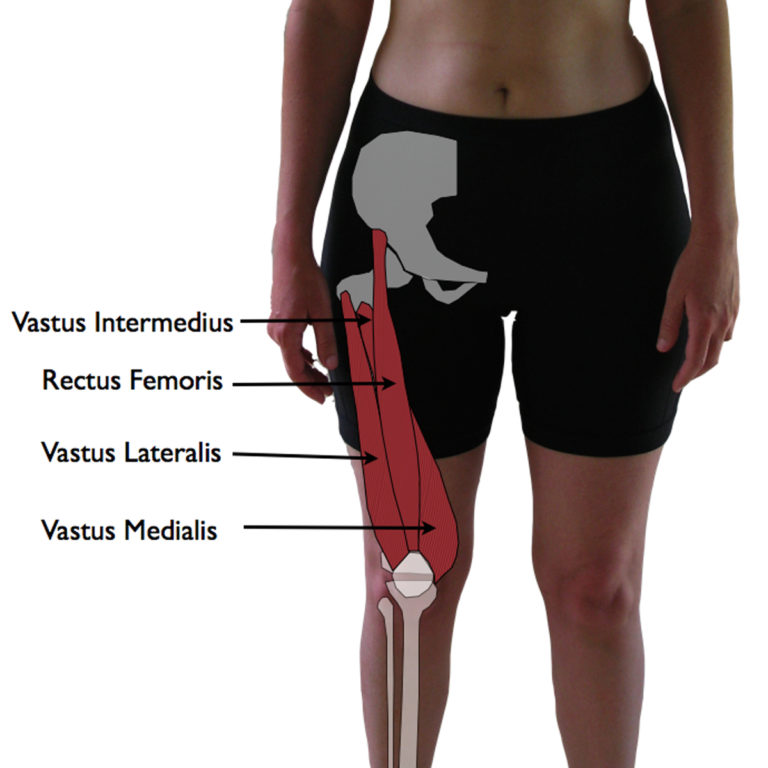
- Vastus medalis
- Vastus lateralis
- Vastus intermediates
- Rectus femoris.
- Vastus medalis muscle
Origin: Inter trochanteric line, pectineal line of the femur, medial supracondylar line of the femur, Linea Aspera,
Insertion: medial supracondylar line of femur Tibial tuberosity (via patellar ligament), median supracondylar line of femur
Action: Knee joint Leg extension
Innervation: Femoral whim-whams (L2-L4)
Blood supply: Femoral, deep femoral, descending genicular arterial - Vastus lateralis
Origin:Inter trochanteric line, inferior trochanter, gluteal tuberosity, Linea aspera of femur
Insertion: Tibial tuberosity (via patellar ligament), Patella, ( Side condyle of the tibia)
Action: Knee joint Leg extension
Innervation: Femoral nerve (L2-L4)
Blood supply: Lateral circumflex femoral and deep femoral arteries; artery of the quadriceps - Vastus intermediates
Origin: Anterior face of femoral shaft
Insertion: Tibial tuberosity (via patellar ligament), patella, ( Side condyle of the tibia)
Action: Knee joint Leg extension
Innervation: Femoral nerve (L2-L4)
Blood supply: deep femoral arteries Artery of the quadriceps, deep femoral arteries - Rectus femoris
Origin: Anterior inferior iliac chine, supra acetabular groove
Insertion: Tibial tuberosity (via patellar ligament), patella
Action: Hip joint: common Thigh flexion, Knee joint: Leg extension
Innervation: Femoral nerve (L2-L4)
Blood supply: Femoral, lateral side femoral circumflex, superficial circumflex iliac arteries
What is the cause of quadriceps muscle strain?

- An acute quadriceps muscle strain is one time your muscle tears quickly and unexpectedly. muscle tears will be due either from injuries or trauma. this will respond to
- Not warming up properly before physical exercise
- Poor flexibility
- Poor exercise
- Overexertion and fatigue
- Weakness
- Acute injuries are generally the result of a single traumatic event and affect macro-trauma to the muscle. There’s a pronounced link between the cause and noticeable symptoms. They do contact sports similar to basketball and rugby soccer because of their dynamic and high collision nature.
- Overuse ( chronic or exercise-induced injuries) is subtler and generally done over a longer period. They result from repetitious micro-trauma to the muscle. Diagnosing is more challenging since there’s a less pronounced link between the cause of the injury and the symptoms.
Quadriceps muscle strains unit classified into three grades
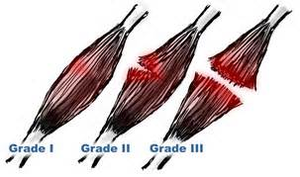
- Grade 1 symptoms: quadriceps strain isn’t ever serious enough to stop training at the time of injury. Pain may be felt in the thigh and an overall feeling of tightness. The athlete may feel mild pain and ach on walking and running might be difficult. There’s unlikely to be swelling. A lump or area of spasm at the point of injury may be felt.
- Grade 2 symptoms: The athlete may feel an unexpected sharp pain when running, jumping, or kicking and be incapable to play. Pain will make walking tough and swelling or mild bruising may be noticed. The pain would be felt when pressing in on the suspected position of the quad muscle tear. Straightening the knee against resistance is likely to cause pain and the injured athlete will be unable to completely bend the knee.
- Grade 3 symptom: consist and unexpected pain in the front of the thigh. The case will be incompetent to walk without the aid of crutches. Bad swelling will appear immediately and expressive bruising within 24hours. A static muscle compression will be painful and is likely to produce a bulge in the muscle. The patient can expect to be out of competition for 6 to 12 weeks
Signs and symptoms:
rely on the open intensity of the injury
- in delicate quadriceps muscle strain could feel slightly stiff, however still versatile enough to be used.
- Unexpected pain in the front side of the thigh.
- Pain or tenderness over the quadriceps muscle.
- Snapping or popping sensation in your quadriceps.
- Swelling and bruising in your quadriceps muscle.
- Limited movement of the quadriceps muscle.
- Quadriceps muscle spasms.
- Muscle weakness.
- Muscle stiffness
Differential Diagnosis
- Jumper’s Knee
- Contusion
- Slipped Capital Femoral Epiphysis
- Femoral Neck Stress Fracture
Assessment
Subjective assessment
- History with associated symptoms
Mechanism of injury
- Inciting trauma-direction and magnitude of injuring force
- Repetitious trauma- defective postural related injuries
Observation
- Strain injuries of the quadriceps may present with an obvious deformity similar to a bulge or defect in the muscle belly.
- Palpation
- Tenderness
- Swelling
Strength test
Strength testing of the quadriceps should include the resistance of hip flexion and knee extension
- Adequate strength testing of the rectus femoris must include resisted hip flexed and extended with knee extension.
- Practically, this is best accomplished by evaluating the patient in both a prone-lying and sitting position.
- The prone-lying position also allows for optimum assessment of quadriceps flexibility and motion.
- Pain is normally felt by the patient with resisted muscle activation, passive stretching, and direct palpation over the muscle strain.
Examination
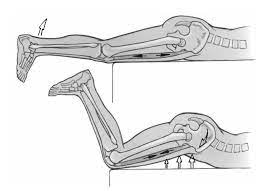
Ely’s test:
- Ely’s test is used to assess rectus femoris tightness or spasticity.
- Method: the patient lies prone, and the examiner passively flexes the patient’s knee .on flexion of the knee, the patient’s hip on the same side spontaneously flexes, indicating that the rectus femoris muscle is tight on that side and that the test positive. the both sides should be tested and compared.
Other assessment methods are:
- Hamstrings/Quadriceps ratio (H vs. Q) – A calculation in which the strength of the hamstring muscles in eccentric movement is divided by the strength of the quadriceps in a concentric movement:
- Asymmetries/imbalance in the functional H/Q ratio was shown to be the remarkable impact of injury prevalence.
- Range of motion decrease (ROM) .
- Muscle strength loss
- Skin temperature
- Pain (under pressure)
- Bruises (ecchymosis)
- Sore end-feel
Outcome measure
- Muscle test: quadriceps force and range of motion.
- Manual muscle testing: There are five grades of manual testing. Grade 0 is the lowest grade where the patient is not able to do the movement. Grade 5 is the exaccive grade where the patient can move his leg against a maximum resistance given by the therapist.
Treatment of Quadriceps strain:
Medical Treatment
- Quadriceps strains infrequently require surgery still may be necessary for a complete rupture.
FOR immediate
- Nonsurgical, Conservative treatment maximum muscle strains do not demand surgery if the muscle is fully damaged doctors suggest surgery If there is a partial gash also the athlete can replace when they are effortless and have normal strength and movement. This generally occurs following anywhere from many weeks to many months of significant treatment and therapy. When the muscle is fully damaged, the athlete may advantage from surgical repair. e tone- care of a muscle strain.
- Some therapists suggest avoiding inimical pain medicines that can extend your threat of bleeding — similar to over-
the-counter (OTC) medicine (naproxen sodium (Aleve) aspirin and ibuprofen (Advil, Motrin IB), — during the first 48
hours after a muscle strain. Acetaminophen (Tylenol) and others can be helpful for pain relief during this period. A
physiotherapist can help you to increase the strength and stability of the injured joint or limb. Your doctor may suggest
that you stabilize the quadriceps with a brace. For some quadriceps muscle injuries, quadriceps muscle sprint surgery may be called.
To prevent swelling and pain as first aid by following RICE principal
- R-rest
- I-ice for cooling
- C-compression tapping and splinting
- E-elevation
the R.I.C.E approach

- Rest. keep down from activities that cause pain, swelling, or discomfort. don’t avoid all physical activity.
- Ice. although you’re seeking medical facilities, ice Loosen the wrap if the ache will extend, place| the world| the area} becomes numb or swelling goes on below the wrapped space. quickly. Use Associate in Nursing associate ice pack or slush tub of ice and water for fifteen to twenty minutes each time and reprise every two to three hours. In contrast, you’re awake for the first few days once the injury.
- Compression. to help stop swelling, compress Loosen the serape if the pain will increase, space| the world| the realm} becomes numb or swelling goes on below the wrapped space. with an associate degree girth until the swelling stops. don’t wrap it too tightly else, you would maybe interfere with circulation. Begin wrapping at the highest farthest from your heart. Loosen the wrap if the pain will increase, space| the world| the realm} becomes numb or swelling goes on below the wrapped space.| Loosen the serape if the pain will increase, space| the world| the realm} becomes numb or swelling goes on below the wrapped space.| Loosen the serape if the pain will increase, space| the world| the realm} becomes numb or swelling goes on below the wrapped space.
- Elevation. Elevate the leg on high of your heart’s extent, significantly at night time, that allows gravity to help reduce swelling.
Knee Positioning
- When a quadriceps muscle strain occurs during a competition or training, it’s important to respond incontinently. In the 10 minutes following the trauma, one needs to put the knee of the affected leg incontinently at 120 ° of flexion.
- This avoids potential muscle spasms, reduces the hemorrhage, and minimizes the danger of developing myositis ossification. Practically, this can be done by placing the patient in a dependent knee brace at 120 ° of knee flexion or using an elastic compression wrap to maintain this position of flexion.
- If the knee is left in extension the healing process will be slower and more painful because the quadriceps will start to heal in a shortened position.
Physical Therapy Treatment
The aim of activity treatment is
- Relieve quadriceps muscle pain, spasm
- Reduce muscle swelling
- Increases quadriceps muscle strengths.
- improve full mobility of the ligament and corresponding joint
- Restore patient’s confidence.
- Restore patients’ full functional activity
Physiotherapy Treatment and Exercise:
Quadriceps muscle strain treatment
- Physiotherapy rehabilitation can be started after 48 hours of injury, For the first few days give an electric modality give to relieve swelling and pain
Ultrasound
- Ultrasound has been used about tissue healing
- Increases blood circulation and mobility.
- To reduce swelling and pain
Cryotherapy
- Inflammation and swelling can be reduced by applying cryotherapy in form of ice packs, and cold water baths to the affected area. Continuous application of cold several times a day for 15-30 minutes at a time is recommended.
TENS
- Trans-cutaneous electrical nerve stimulation (TENS) may be able to help reduce pain and muscle spasms.
Rehabilitation of the Quadriceps muscle strain
Phase one- one week after injury
- ice application, 3 times per day
- compression
- isometric exercise: An isometric quadriceps sets, 10 repetition
- Hamstring sets, 10 repetition
- Glut sets,10 repetition
- Vastus Medalis Obliques
After pain relief give some active exercise
Phase two -3 week to 12 week
Active exercise:
- knee flexion
- knee extension
- hip flexion
- hip extension
- hip adduction
- hip abduction
–Strengthening and stretching exercise

1-Step ups: Start with a box height that’s comfortable for you to step upon. Be sure to keep your knee in alignment with your alternate toe. Step up and keep your pelvis position and your knee in alignment. Be sure to engage the buttocks muscles and completely lock out the knee. Return slow back down to the ground. The focus should be on the slow eccentric (lowering) back to the ground for 1 second over and 3 seconds down. Perform 2 sets of 15-20 repeats one time per day.
2-Isometrics: Initial isometrics with quadriceps contractions done with the knee fully extended and in different positions at 20-degree increments as knee flexion improves May discontinue isometrics when the patient can sit comfortably.Straight leg raise.

3–Static quad stretch: This can be performed either by standing or laying on your front. Pull the foot of the injured leg towards your buttock until you can feel a gentle stretch on the front of the ham. To increase the stretch, tilt your hips back. Hold for 15-30 seconds and repeat. go this at least 3 times a day.

4-Stretching: Stretching should be done carefully and always to the point of discomfort, but no pain. Various techniques can be used including passive, active-passive, dynamic, and proprioceptive neuromuscular facilitation stretching. Generally, ballistic stretching is discouraged due to the danger of -tearing muscle fibers. However, stretch the quad muscles, If it’s pain-free.
5-Isotonics: Once patients achieve terminal knee extensions right without extensor lag, the therapist adds free weights to the street leg raises and terminal knee extensions. Begin with the lowest free weight that the patient can lift; three sets of 10 repetitions up to three times per day. Increase weight by no further than 2-3 pounds at any given time and increase no sooner than every two successive workdays.
Phase three-after 12 week

- Wall squats: From your starting position, slow less your body downward, and hold for time. As you perfect, extend the volume of time you hold the wall squat. Be sure to observe your pelvis, back, and head against the wall. Keep the movement pain-free. (A variation to increase activation of the VMO would be to squeeze a ball in the middle of your knees as you perform the exercise. Typically the ball would be about 12 inches in diameter.) Perform 3 sets of 15-20 seconds holds onetime per day.
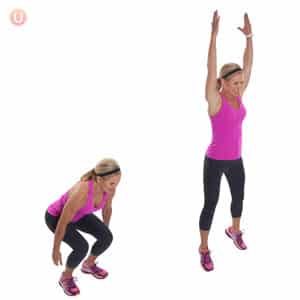
2. Squat jump: Stand with your feet shoulder-width apart. Start by going a regular squat, engage your core, and jump up explosively. When you land, lower your body back into the thickset position to complete one rep. Make sure you back down with your entire bottom on the ground. Do two to three times of 10reps per day.

3. Split jumps: Stand high with your feet hip distance apart. Hands are in the front line of the chest hand on a fist. Take a big move ahead with one foot and lower your body toward the floor. patients would bend both legs at a 90- degree angle at the bottom of the jab. Lower the reverse knee slightly and jump to switch the feet. While in the air front line foot comes sequential foot comes to the front. Land in a bent knee lunge. Reprise.
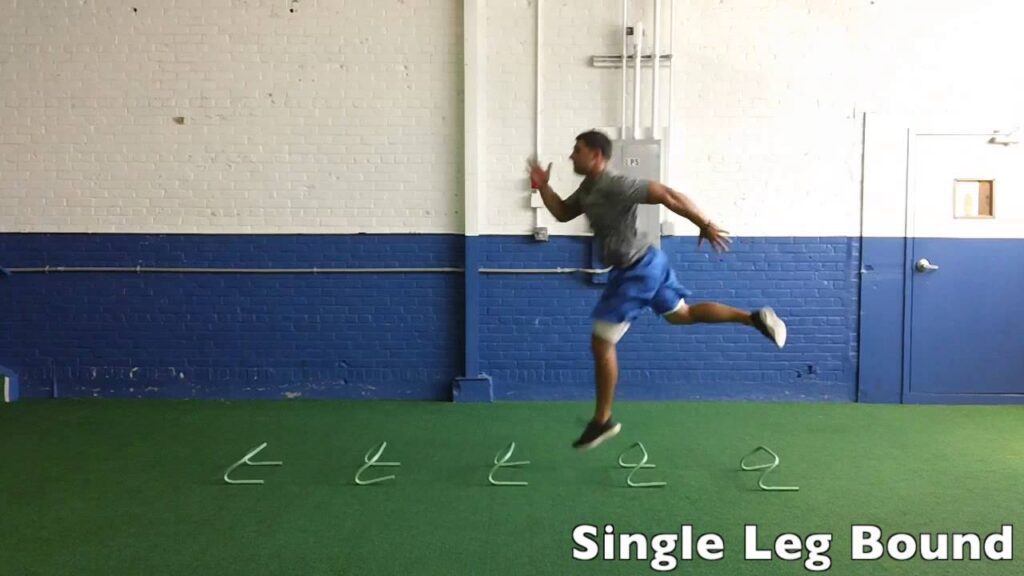
4. Single leg bounding: equilibrium on your right leg. Jump upwards and forward as far as you can, Land on the same foot you jumped from, and as soon as you land jump again. Repeat this movement for the desired amount of repetitions and then switch legs.
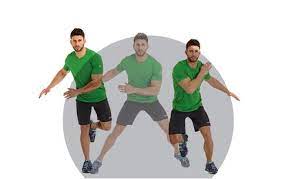
5. lateral bounding: Stand in a half-squat with your feet about shoulder-width apart, Push off your left foot to hop to the right. come down with all of your weight on your right foot and keep your left foot lifted. Pause for a motion and push off your right foot to jump left. come down on your left foot to proper a repatriation.
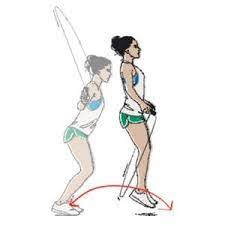
6. Backward skips: Hold the jump rope with elbows at your side and handles pointing sideways away from your body. Jump with your feet together, and rotate the rope backward.
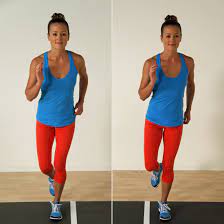
7. Lateral hops: Keeping your legs together, jump from side to side, jump over an imaginary obstacle, Land with soft knees, Try to remain on the balls of your feet
Other treatment:
Surgical treatment
- One should exercise extreme caution in considering surgical intervention in the treatment of muscle injuries, as a properly executed nonoperative treatment results in a good outcome in virtually all cases. The phrase “muscle injuries do heal non operating ” ,we can use as a guiding principle in the treatment of muscle traumas.
Preventive measures
- Do Regular stretching and strengthening exercises for your sports, fitness, or work exertion, as a part of your overall physical activities
- An exercise program can help to minimize your danger of muscle strains.
- Try to be in a shape to play your sport; don’t play your sport to get in shape.
- If you have a physically demanding occupation, regular exercise can help to help injuries.
- Follow a healthy diet and an exercise program to maintain a healthy weight. The overweight can put added pressure on the muscles, making muscle strains again probable to do.
- Walk at a moderate footstep for 3 to 5 minutes before doing any sports or a different physical activity.
- Going this will warm up the muscles and prepare them for an increase in the intensity of the exercise.


